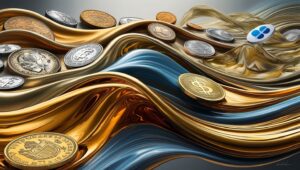Currency
In both finance and biology, the concept of “currency” is more than a simple transaction—it’s a dynamic, circulating force that powers growth, resilience, and vitality. Just as currency flows through the economy, keeping societies alive and growing, energy flows within the body, fueling movement, thought, and life itself. Here, we’ll explore the fascinating parallels between these two forms of flow and how understanding them can bring deeper insights into both our financial systems and our physical well-being.
1. Circulation as the Foundation of Health and Wealth
In any thriving system, whether economic or biological, circulation is key. Currency flows through the economy in much the same way blood flows through the body, sustaining life by bringing resources where they’re needed most. Economists talk about the “velocity of money” to describe how quickly currency changes hands in a healthy economy. A high velocity indicates a vibrant economy where money is constantly in motion, just as a healthy body depends on active circulation of blood, oxygen, and nutrients.
When this flow is interrupted—whether through financial barriers, economic instability, or physical blockages in the body—the system suffers. Financially, we see stagnation in the form of economic recessions; physically, we may experience fatigue, inflammation, or illness. Both cases illustrate how vital continuous, balanced flow is to overall health and prosperity.
2. Channels and Pathways: Economic Institutions and Body’s Energy Meridians
In the economy, banks, businesses, and markets act as channels for the movement of currency. In the body, energy flows along pathways known as meridians (in Traditional Chinese Medicine) or nadis (in Ayurveda). These channels keep both systems in balance and allow resources to move efficiently. Just as a blockage in a river or financial system disrupts the flow, an obstruction in the body’s energy pathways can cause discomfort or disease.
Financially, well-functioning institutions like banks and governments help regulate money flow, directing it toward productive areas. Similarly, our body’s circulatory and nervous systems ensure that energy is distributed where it’s needed, responding to stress, physical demands, and recovery needs. Both systems rely on these channels to function smoothly and support balance.
3. Stored Energy and Wealth as Potential Power
In both economics and biology, reserves of energy or currency represent potential power. In the body, stored nutrients and energy reserves allow us to exert effort, face challenges, or simply get through the day. In the economy, savings and investments provide the resources to create growth, fund new projects, and face economic challenges.
Financial reserves provide security, just as the body relies on stored energy during times of stress or exertion. This stored potential—whether in a bank account or in bodily reserves—represents resilience. Having these reserves is crucial for times of crisis, offering a cushion that enables recovery and supports sustainability.
4. Balance and Homeostasis: Economic Equilibrium and Bodily Health
The body maintains balance, or homeostasis, by regulating its internal environment. Similarly, financial systems seek equilibrium. For instance, central banks adjust interest rates and manage inflation to keep the economy stable. Just as too much or too little of any bodily element—be it temperature, hydration, or oxygen—disrupts balance, economic imbalances, like high inflation or deflation, can cause instability.
In both systems, dynamic adjustments are necessary to maintain balance. The body uses complex feedback mechanisms to adjust its responses to external stress, and financial systems rely on fiscal policies, regulations, and market indicators to maintain equilibrium. Both processes underscore the importance of regulation and adaptability in maintaining health and prosperity.
5. Energy Exchange: The Economy as a Living System
Money is often viewed as a form of energy exchange—representing the value of work, creativity, and resources. Similarly, in the body, energy exchange happens constantly, as nutrients are converted into fuel and bodily energy is spent on movement, thought, and cellular function. Money, like bodily energy, needs to circulate; it’s meant to be spent, invested, or saved for future use.
When we think of money as a form of energy, we understand that it’s not meant to be hoarded or stagnated. In the economy, constant exchange—whether through spending, investing, or trading—is essential. Likewise, in the body, energy flows are sustained through breathing, eating, and activity, supporting the entire system. Both forms of currency—the body’s energy and financial money—are designed to move and fuel growth.
6. Preventing Stagnation: The Need for Healthy Flow in Both Systems
Stagnation can have harmful effects in both systems. Financially, when money stops circulating, economies slow down, unemployment rises, and productivity declines. In the body, stagnation—whether due to lack of exercise, poor diet, or stress—can lead to fatigue, inflammation, and chronic health issues. Just as economists encourage spending to stimulate growth, health experts encourage movement, exercise, and balanced nutrition to keep energy flowing.
Both systems benefit from regular “maintenance”: governments implement policies to encourage spending and investment, while we can support our bodies through regular exercise, balanced nutrition, and mindful practices that promote healthy circulation. In both cases, the objective is the same: keep the energy flowing to prevent stagnation and maintain vitality.
7. The Global Flow of Currency and Energy Across Systems
Currency flows beyond national borders, linking global economies. This interconnected flow creates an economic ecosystem, where events in one country can impact economies worldwide. Similarly, the body’s systems are interconnected—what we eat, think, and do affects our overall well-being. In both cases, flow across systems is crucial for a balanced, thriving whole.
Exchange rates, trade policies, and international investments guide the flow of money across borders, affecting jobs, industries, and opportunities. In the body, nutrients, hormones, and neural signals move across systems, coordinating complex functions. Just as healthy global exchange fosters growth, harmonious bodily function supports holistic health.
8. Currency as Life Force: A New Perspective on Wealth and Energy
Understanding currency as a form of energy aligns with many ancient philosophies that view wealth as a life force. Just as the body’s vitality relies on healthy energy flow, true wealth relies on balanced currency flow. Financial wealth is more than accumulation; it’s about the dynamic flow that generates growth, opportunity, and well-being. Similarly, a healthy body isn’t just about stored energy but about the ability to harness, circulate, and rejuvenate that energy.
By viewing currency through this lens, we appreciate it as a living, circulating force that sustains both individuals and society. Money and energy are both powerful tools that, when used wisely, enhance well-being, creativity, and growth. Recognizing this dynamic relationship between currency and the body’s energy can transform how we approach both our finances and our health.
In both economic and personal realms, currency—whether in the form of money or energy—gains power from its flow. This understanding can help us build healthier relationships with money and cultivate a balanced, energized lifestyle that supports our goals, relationships, and communities. When currency flows freely, it empowers not just individual well-being but the thriving, interconnected systems in which we all live.





